What can be done to save the Massachusetts coastline
BOSTON − A state commission is trying to figure out how to defend the coastline from global warming's "existential threat."
After focusing on whether people of all races and abilities feel welcome at public beaches in the Boston Harbor region, the Metropolitan Beaches Commission is turning its attention to what the area needs to stave off rising seas.
The commission held the first in a series of hearings last week to gather input on a preliminary report that focuses on the conditions and potential for flooding at 14 area beaches managed by the state Department of Conservation and Recreation, including Wollaston and Nantasket beaches.
The commission, which was created by the Legislature in 2006, consists of community leaders and legislators, including state Sens. Patrick O'Connor, R-Weymouth, and John Keenan, D-Quincy, and state Reps. Joan Meschino, D-Hull, and Tackey Chan, D-Quincy.

"We've spent 30, 40 − longer − years investing in these recreational resources, cleaning them up," Chris Mancini, executive director of Save the Harbor/Save the Bay, said in the virtual hearing. "Now we're looking at this ... existential threat to these resources."
Those rising waters pose a threat to "our lives" in extreme cases, Mancini said.
Julia Knisel, coastal shoreline and floodplain manager for the state Office of Coastal Zone Management, said sea levels are projected to rise 1.2 feet by 2030, 3.2 feet by 2060 and 7.6 feet by 2100.
Sea walls and other structures intended to block surges are in place, but Knisel said many of them were built more than 100 years ago, when sea levels were a foot lower than they are today. Knisel called for assessing the height of those structures compared to where sea levels are at today, and where they'll be in the future.
She shared a photo of a beach parking lot full of sand and gravel that had washed over a sea wall. She said major storms push that debris off the shoreline and the result is that beaches lose "volume."
"What we really need to start talking about is beach lowering, not just beach erosion back into the community. We are losing beach volume, and that's something we really need to address," Knisel told the commission.
The toolkit for dealing with these issues can include raised harborwalks, raised sand dunes and berms, and vertical flood walls, said Catherine McCandless, Boston's climate resilience project manager.
She pointed to Constitution Beach in East Boston, where dunes with a "reinforced core" were installed that help protect the MBTA's Blue Line from flooding.
The report discussed at the meeting was written by a Harvard University graduate student for Save the Harbor/Save the Bay.
The report says Wollaston Beach's sea wall is in "excellent condition," but the area is vulnerable to flooding from major storms.
"While sea wall infrastructure is in place along the coast, overtopping of this infrastructure has the potential to lead to inland flooding in developed areas," the report states. That can create "potentially dangerous environments for residents," it says.
Knisel lauded "good work" in Hull, where the "dune grass is filling in, and we have a nice growing coastal buffer here to help address coastal storm impacts in the community."
Christian Krahforst, Hull's climate adaptation and conservation director, said the dunes are sacrificial.
"They're the physical entity that bears the brunt of overwashed storm surge," Krahforst said.
Nick Connors, of the Department of Conservation and Recreation, said upcoming revisions to Nantasket Beach's master plan will be made "with sea level impacts in mind."
Bruce Berman, the Metropolitan Beaches Commission's lead consultant, wondered how much it will cost to defend the coastline.
The key, he said, is "managing and planning a way for the city, for the state and, frankly, for the federal government resources to come into play here."
Patriot Ledger staff contributed to this report.
This article originally appeared on The Patriot Ledger: What can be done to save the Massachusetts shores

